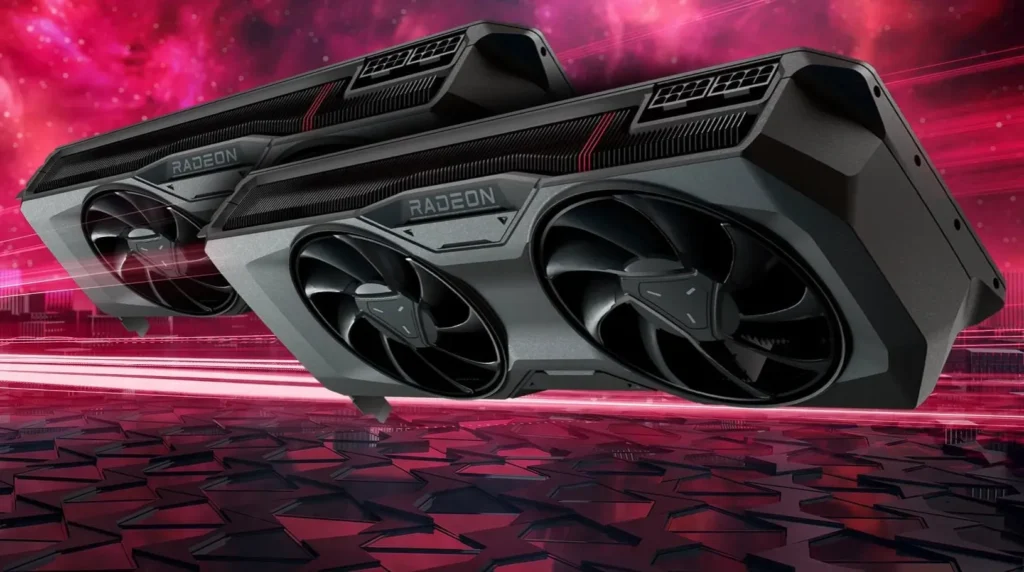Are you a PC gamer eagerly waiting for the next big thing in gaming graphics? You’re not alone! Gamers everywhere are buzzing with excitement about the upcoming Radeon RX 9070 and 9070 XT graphics cards from AMD. Following a tough competition with Nvidia, who recently sold out their latest GPUs, AMD is set to make a splash in the gaming world. With promises of amazing features like better ray tracing and AI technology for smoother 4K gaming, these new cards are expected to hit store shelves in early March. Let’s dive into what makes these graphics cards so special and why you should be excited!
| Category | Details |
|---|---|
| Upcoming GPUs | RX 9070 and 9070 XT expected in early March 2025. |
| AMD CEO | Dr. Lisa Su stated that RDNA 4 improves ray tracing and supports AI upscaling for 4K gaming. |
| Market Situation | Nvidia’s GPUs sold out quickly; AMD’s Radeon designs have not yet been showcased this year. |
| Earnings Call Highlights | Desktop CPU sales are up 58%, but gaming sector sales are declining. |
| Radeon Cards Positioning | New cards are seen as budget-friendly alternatives to Nvidia’s offerings. |
| Previous Models | Radeon RX 7900 XT, 7900 GRE, 7800 XT priced at $900, $550, and $500 respectively. |
| Next Steps | An event is rumored for late February for further announcements. |
The Exciting Arrival of AMD’s RX 9070 Series
PC gamers are buzzing with excitement as AMD prepares to launch its new RX 9070 series graphics cards. After months of speculation and waiting, the CEO of AMD has confirmed that these cards will be available in early March. This news is a relief for many, as gamers have been eagerly looking for alternatives to Nvidia’s high-priced offerings. With the RX 9070 and 9070 XT on the horizon, players can expect to experience enhanced gaming performance without breaking the bank.
The RX 9070 series promises to deliver impressive advancements in graphics technology. Built on the new RDNA 4 architecture, these cards are designed to offer better ray tracing performance and support for AI-powered upscaling. This means that gamers can enjoy stunning visuals in their favorite titles, even at high resolutions like 4K. As AMD gears up for this launch, many are hopeful that these new GPUs will provide a budget-friendly option to compete with Nvidia’s expensive graphics cards.
AMD’s Strategy and Market Impact
AMD’s upcoming RX 9070 series could significantly change its standing in the gaming market. The company plans to merge its CPU and GPU reports, showing a unified approach to its technology offerings. This strategy comes at a crucial time as AMD aims to regain a stronger foothold in a market currently dominated by Nvidia. With a successful launch, AMD could attract more gamers looking for powerful yet affordable options, especially as sales for current-gen consoles decline.
As AMD prepares for the launch of these new graphics cards, it faces challenges from the ongoing global trade issues and tariffs. These factors could impact the pricing and availability of the RX 9070 series, leaving gamers curious about how much they will need to spend. Despite this uncertainty, the anticipation surrounding these new GPUs remains high. Many gamers are hopeful that AMD will provide a solid alternative to Nvidia, allowing more players to upgrade their setups without overspending.
What to Expect from the RX 9070 GPUs
As we await the release of the RX 9070 GPUs, there are many questions about their specifications and capabilities. While AMD has not revealed all the details yet, the focus on RDNA 4 architecture suggests significant improvements in performance and efficiency. Gamers are particularly interested in how these cards will compare to the existing models, like the RX 7900 series, especially in terms of pricing and performance. With rumors of a product event in February, enthusiasts are eager for more information.
Another exciting aspect of the RX 9070 series is the promise of high-quality gaming experiences at a lower cost. As AMD provides budget-friendly options, it opens the door for more players to enjoy cutting-edge graphics. This could lead to a surge in gaming popularity, especially for those who may have been hesitant to invest in higher-priced Nvidia cards. The hope is that AMD will deliver on its promises, giving gamers a reason to celebrate the new wave of graphics technology.
Anticipating the RX 9070 and 9070 XT: What to Expect
As the excitement builds for the upcoming RX 9070 and 9070 XT, gamers are eager to see how AMD’s new RDNA 4 architecture will enhance their gaming experience. These graphics cards are expected to deliver superior ray tracing capabilities, making high-quality visuals more accessible to mainstream players. With the promise of AI-powered upscaling technology, AMD aims to provide a competitive edge against Nvidia’s offerings, ensuring that gamers can enjoy stunning 4K graphics without breaking the bank.
However, the anticipation is not without its challenges. With Nvidia’s recent dominance in the GPU market, AMD faces immense pressure to deliver a product that not only meets but exceeds expectations. The RX 9070 series could play a crucial role in reviving AMD’s gaming sector, especially as the company looks to combine its CPU and GPU segments. Gamers are hopeful that these new cards will provide a budget-friendly alternative while still offering high performance and cutting-edge features.
Market Dynamics: AMD vs. Nvidia
The current GPU landscape is heavily influenced by the rivalry between AMD and Nvidia. Nvidia’s latest graphics cards have seen record sales, often selling out within hours, which has only intensified the urgency for AMD to launch its RX 9070 series. This competition is not just about performance; it’s a race to capture the hearts of PC gamers who are increasingly frustrated by rising prices and limited availability of high-end graphics cards.
AMD’s strategy to position the RX 9070 series against Nvidia’s offerings could shift market dynamics significantly. With the gaming sector experiencing a decline, AMD must leverage its upcoming GPUs to regain market share and bolster its reputation. As they prepare for the launch, AMD’s ability to deliver performance at competitive prices will be crucial in attracting gamers who have been gravitating towards Nvidia’s high-priced solutions.
The Impact of Global Trade on GPU Pricing
As we await the launch of the RX 9070 and 9070 XT, it’s essential to consider the broader implications of global trade dynamics on GPU pricing. With existing tariffs and potential future trade restrictions, manufacturers may face increased costs that could trickle down to consumers. AMD’s ability to keep pricing competitive amidst these challenges will be vital for its success in the marketplace.
The uncertainty surrounding global trade could lead to unpredictable pricing for the new Radeon cards. Gamers are understandably anxious about how tariffs and supply chain disruptions will affect their purchasing power. By keeping a close eye on these developments, AMD may have to adapt its pricing strategy to ensure that the RX 9070 series remains an appealing option for budget-conscious gamers looking to upgrade their systems.
What Does RDNA 4 Mean for Future Gaming?
The introduction of RDNA 4 architecture is a significant milestone for AMD, promising advancements that could reshape the future of gaming. Enhanced ray tracing performance and AI-driven features are set to elevate the visual fidelity and immersive experience of games. This leap in technology not only showcases AMD’s commitment to innovation but also sets the stage for developers to explore new creative possibilities in game design.
Moreover, RDNA 4’s capabilities could lead to a more competitive landscape, pushing both AMD and Nvidia to continually innovate. As gamers increasingly demand high-quality graphics and performance, the technological advancements from the RX 9070 series could inspire a new wave of gaming titles that fully utilize these features. This evolution in GPU technology is not just about performance; it’s about redefining how we experience games in the coming years.
Frequently Asked Questions
What are GPUs and why do gamers care about them?
**GPUs**, or Graphics Processing Units, are special parts of computers that help create images and videos. Gamers care about them because powerful GPUs make games look better and run smoother, which makes playing more fun.
What is the RX 9070 GPU and when will it be available?
The **RX 9070** is a new graphics card from AMD expected to be available in **early March**. It promises to improve game graphics and performance, making it exciting for gamers waiting for upgrades.
Why are AMD’s new graphics cards important for PC gaming?
AMD’s new cards are important because they use advanced technology, like **RDNA 4**, which helps games look great and run faster. This can offer gamers a more enjoyable experience without spending too much.
What does ray tracing mean in gaming?
**Ray tracing** is a technique that makes light in games look more realistic. It helps create shadows and reflections that are closer to how we see them in real life, improving the overall look of games.
How does AMD plan to compete with Nvidia in the GPU market?
AMD plans to compete by releasing new GPUs like the **RX 9070**, which are expected to perform well and be more affordable than Nvidia’s options. This gives gamers more choices for their PCs.
What challenges is AMD facing with their new GPUs?
AMD faces challenges such as **high prices** and competition from Nvidia. Additionally, global trade issues might make new electronics even more expensive, which could affect how many people can buy them.
What does AI-powered upscaling mean for gaming?
**AI-powered upscaling** is a technology that helps games look better by improving lower-quality images to higher resolutions. This means players can enjoy sharper graphics without needing super expensive hardware.
Summary
The content discusses the anticipation among PC gamers for new desktop GPUs, particularly AMD’s upcoming RX 9070 and 9070 XT, expected in early March. AMD’s CEO, Dr. Lisa Su, highlighted that these cards will feature enhanced ray tracing performance and AI-powered upscaling technology. Despite strong sales in desktop CPUs, the gaming sector faces challenges due to Nvidia’s dominance and declining console demand. AMD plans to merge its CPU and GPU business reports, while specifics about the new GPUs remain limited. The pricing and impact of global trade tariffs on these cards are still uncertain.








